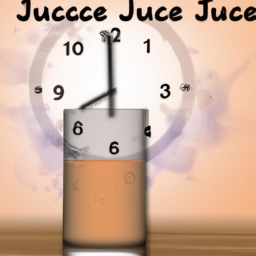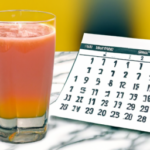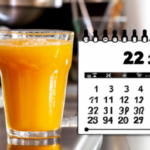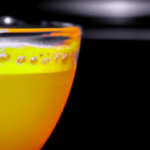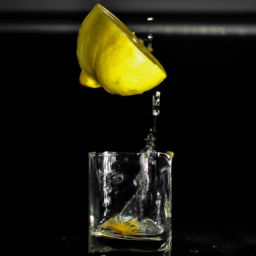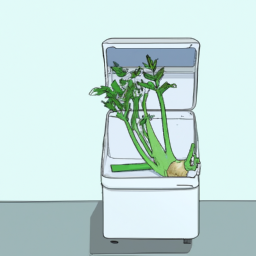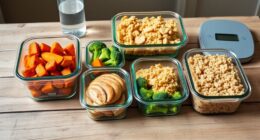Have you ever wondered how long fresh squeezed juice can sit out at room temperature before it goes bad?
As a juice enthusiast myself, I understand the importance of proper juice storage to maintain its freshness and nutrients.
But with so many factors affecting the shelf life of juice, it can be difficult to know how long it’s safe to leave your juice sitting out on the counter.
In this article, I will delve into the science behind juice storage and the factors that can affect its shelf life.
I will also provide tips on how to properly store your juice to ensure it stays fresh for as long as possible.
With this knowledge, you can enjoy your favorite juice without worrying about its safety or losing its nutritional value.
Key Takeaways
- Freshly squeezed juice has a room temperature shelf life of 2-4 hours and a fridge shelf life of 2-3 days.
- Proper refrigeration at 32-40°F can extend the shelf life of juice and slow down bacterial growth.
- Leaving juice out at room temperature for too long can cause bacterial growth and pose a serious health risk.
- If juice has been left out for too long and lost its freshness, it’s generally recommended to dispose of it properly.
The Importance of Proper Juice Storage
You need to make sure you’re storing your juice properly, or else it’ll quickly go bad and become a breeding ground for harmful bacteria. Proper juice storage involves practicing good hygiene and preservation techniques to ensure that your juice stays fresh and safe to consume.
One of the first things to consider is the type of container you’re using to store your juice. Glass containers are ideal because they don’t leach chemicals into the juice, and they’re easy to clean. Plastic containers, on the other hand, can absorb odors and flavors, which can negatively affect the taste of your juice.
Another important factor to consider is the juicing technique you’re using. Maximizing nutrient retention is key to getting the most out of your juice, but it can also impact how long your juice will last. Slow juicers, for example, tend to produce more nutritious juice that lasts longer than fast juicers.
Additionally, storing your juice in the refrigerator as soon as possible after juicing can help to preserve its freshness. All of these factors can play a role in determining how long your juice will last, so it’s important to pay attention to the details when it comes to proper juice storage.
With that said, let’s take a look at some other factors that can affect juice shelf life.
Factors That Affect Juice Shelf Life
The clock is ticking on the lifespan of your favorite fruit drink as it’s subject to a host of variables that can impact its freshness.
Factors affecting juice spoilage include pH level, temperature, exposure to light and air, and the addition of preservatives. High acidity levels and warmer temperatures can hasten the breakdown of nutrients and encourage the growth of harmful microorganisms, leading to spoilage.
To preserve the freshness of your juice, it’s best to store it in a cool, dark place. Refrigeration is the most effective way to slow down the process of spoilage and extend the shelf life of your juice. Properly sealed containers can also help prevent contamination from outside sources.
Best practices for juice preservation also include consuming the juice within a few days of opening, avoiding exposure to direct sunlight, and refraining from reusing containers that haven’t been thoroughly cleaned and sanitized.
By following these guidelines, you can enjoy your juice at its peak freshness for as long as possible before it reaches its expiration date.
As we now understand the factors affecting juice spoilage and best practices for juice preservation, it’s important to know how long juice can sit out before it goes bad.
How Long Can Juice Sit Out?
When it comes to the shelf life of juice, there are two main factors to consider: unopened juice and opened juice. Unopened juice can typically last for several months past its expiration date if stored properly in a cool, dry place.
However, once juice has been opened, it should be consumed within a few days to prevent spoilage and potential foodborne illness.
Shelf Life of Unopened Juice
Juice lovers, rest assured that unopened juice can last for several months when stored properly. The shelf life of unopened juice depends on several factors such as the type of juice, packaging, and preservative use. For instance, pasteurized juice that is stored in a sealed container can last for up to eight months in the fridge. However, unopened fresh juice that has no preservatives can only last for up to seven days.
To give you a better idea of the shelf life of unopened juice, below is a table that shows the approximate duration that different types of juice can last when stored in unopened containers:
| Type of Juice | Shelf Life (Unopened) |
|---|---|
| Apple Juice | 8 months |
| Orange Juice | 6 months |
| Cranberry Juice | 12 months |
| Grape Juice | 12 months |
As you can see, the shelf life of unopened juice varies depending on the type of juice. It’s important to note that the shelf life of juice can also be affected by how it’s stored. It’s always best to store juice in the fridge and away from direct sunlight to ensure that it lasts as long as possible.
Moving forward to the next subtopic, let’s discuss the shelf life of opened juice.
Shelf Life of Opened Juice
You can increase the lifespan of your opened juice by refrigerating it and sealing it tightly with a lid or plastic wrap. This is because juice preservation techniques like refrigeration help to slow down the growth of bacteria that can cause spoilage.
Additionally, sealing the juice with a lid or plastic wrap helps to prevent oxygen from getting in, which can cause oxidation and lead to a sour taste. Best juice storage practices also include using a clean glass or plastic container for your juice, as dirty containers can introduce bacteria that can spoil the juice.
It’s also important to check the expiration date on the juice before opening it, as expired juice is more susceptible to spoilage. By following these best juice storage practices, you can enjoy your opened juice for a longer period of time without worrying about it going bad.
If you notice any signs that your juice has gone bad, such as a foul odor, mold, or a change in color, it’s best to discard it immediately. These signs indicate that the juice has spoiled and may not be safe to consume.
To avoid wasting your juice, be mindful of its shelf life and consume it within a reasonable time frame.
Signs That Your Juice Has Gone Bad
If your juice smells funky or has a strange taste, it may have gone bad. As juice sits out, it can become a breeding ground for bacteria, which can cause spoilage and health risks.
Here are four signs that your juice has gone bad:
-
Mold: If you see mold floating around in your juice, it’s time to toss it out.
-
Foul Odor: If your juice smells sour, rancid or off-putting, it’s no longer safe to consume.
-
Bubbles or Foam: If you notice bubbles or foam on the surface of your juice, this could be a sign of fermentation, which means it’s gone bad.
-
Change in Color: If your juice has a different color than when you first opened it, this could be a sign of spoilage.
It’s important to be aware of these signs of spoilage, as consuming bad juice can lead to health risks. To prevent this, it’s important to properly store your juice.
Tips for Storing Juice
Wow, keeping your juice fresh can be a real challenge, but with these tips for storing it properly, you’ll be able to enjoy delicious, healthy juice for days to come!
One of the best ways to keep your juice fresh for a longer period is to vacuum seal it. This method removes all the air from the container, preventing oxidation and reducing the growth of bacteria and mold. You can use a vacuum sealer machine or manually remove the air from the container using a straw. Once you’ve vacuum sealed your juice, it can last up to 2 weeks in the refrigerator.
Another way to store your juice is to freeze it. Freezing is a great option if you have more juice than you can drink in a few days. Simply pour the juice into an airtight container, leaving some space at the top for expansion. You can also freeze the juice in ice cube trays and then transfer the cubes to a freezer bag. Frozen juice can last up to 6 months in the freezer.
When you’re ready to drink the juice, simply thaw it in the refrigerator or at room temperature.
Now that you know how to properly store your juice, let’s move on to the next section where we’ll discuss how to tell if your juice is still good.
How to Tell If Your Juice Is Still Good
As someone who consumes juice regularly, it’s important to know how to tell if your juice is still good.
Firstly, check the expiration date on the packaging to ensure that it hasn’t passed.
Secondly, perform a smell test to detect any off-putting odors that may indicate spoilage.
Lastly, look for any mold growth or cloudiness in the juice, as these are signs that it has gone bad and should not be consumed.
By following these simple steps, you can ensure that you’re drinking safe and fresh juice.
Check the Expiration Date
Make sure to check the expiration date of the juice before consuming it, as drinking expired juice can lead to potential health risks. It is important to note that the expiration date is not a guarantee of freshness, but rather a guideline for when the juice is at its best quality. Additionally, proper juice handling techniques can also affect the shelf life of the juice.
To better understand the importance of checking the expiration date, refer to the table below. The table compares the recommended shelf life of different types of juice when stored in the fridge and when left at room temperature. It is important to follow the recommended storage guidelines to ensure the juice stays fresh and safe to consume.
| Juice Type | Fridge Shelf Life | Room Temperature Shelf Life |
|---|---|---|
| Freshly squeezed juice | 2-3 days | 2-4 hours |
| Pasteurized juice | 5-7 days | 2-4 hours |
| Shelf-stable juice | Up to 1 year | Up to 1 year |
With a better understanding of how long juice can sit out, it is important to also perform a smell test before consuming the juice. This allows for the detection of any signs of spoilage, such as a sour or rancid smell. By following these tips, you can ensure the juice you consume is both fresh and safe.
Perform a Smell Test
As I mentioned earlier, checking the expiration date is crucial in determining the freshness of juice. However, sometimes the expiration date may not be accurate, or the juice may have been left out for too long, causing it to spoil.
In such cases, performing a smell test can help identify spoiled juice. To perform a smell test, simply open the container of juice and take a whiff. If the juice smells sour or has a rancid odor, it’s likely spoiled and should not be consumed. However, if the juice smells normal, it may still be safe to drink.
But what if the juice has been left out for a while and has lost its freshness? Unfortunately, there are no surefire ways to revive old juice, and it’s generally recommended to dispose of it properly.
Pouring it down the drain or flushing it down the toilet is not the proper way to dispose of spoiled juice, as it can contaminate the water supply and harm the environment. Instead, it’s recommended to pour the juice into a sealable bag or container and dispose of it in the trash.
As we move on to the next section, it’s important to note that if the juice is showing signs of mold or cloudiness, it’s likely too late to salvage it. But how can we identify these signs?
Look for Mold or Cloudiness
You can easily spot mold or cloudiness in your juice by checking for any unusual discoloration or texture. This is a clear sign that your juice has started to spoil. Mold can develop on the surface of the juice or at the bottom of the container. Cloudiness, on the other hand, is caused by bacteria growth. If you notice either of these signs, it’s best to discard the juice immediately.
To avoid spoilage in the first place, it’s important to pay attention to the pH levels in your juice. The pH level is a measure of the acidity or alkalinity of a substance, and it can affect how quickly bacteria and mold grow. Juice with a pH level below 4.6 is more acidic and less likely to spoil quickly.
By monitoring the pH levels and storing the juice properly, you can extend the shelf life of your juice and reduce the risk of spoilage.
Ensuring the safety of your juice is crucial for maintaining good health. By being mindful of spoilage and pH levels, you can enjoy your juice without any worries.
Safe Juice Consumption Habits
As someone who understands the importance of safe juice consumption practices, I strongly advise against drinking expired juice. Consuming expired juice can lead to food poisoning, which can cause nausea, vomiting, and diarrhea.
Additionally, it’s important to always use clean glasses and containers when drinking juice. Avoid cross-contamination by washing your hands before handling any food or drink.
Don’t Drink Expired Juice
Drinking expired juice can lead to food poisoning, so it’s important to always check the expiration date before consuming. Even if the juice looks and smells fine, there is a risk of harmful bacteria growing in the juice over time. When juice is past its expiration date, it may also lose its nutritional value and taste. Therefore, it’s best to err on the side of caution and dispose of any expired juice.
To further emphasize the importance of checking juice expiration dates, here is a table that outlines the potential health risks associated with consuming expired juice:
| Health Risks | Description |
|---|---|
| Food Poisoning | Consuming expired juice can lead to gastrointestinal issues, such as vomiting and diarrhea, caused by harmful bacteria that may have grown in the juice. |
| Allergic Reactions | Over time, the ingredients in the juice may break down and cause an allergic reaction in individuals with certain food sensitivities. |
| Reduced Nutritional Value | Expired juice may lose its nutritional value, leading to a decrease in vitamins and minerals that the body needs. |
| Off Taste | Even if the juice is not harmful, it may have a strange taste or smell due to the breakdown of ingredients over time. |
| Mold Growth | If juice is left out for too long, it can develop mold, which can be harmful to consume. |
Remember to always check the expiration date before consuming juice to avoid any potential health risks. Additionally, it’s important to use clean glasses and containers to prevent contamination and further reduce the risk of food poisoning.
Use Clean Glasses and Containers
Make sure your glasses and containers are as clean as a whistle to prevent any harmful bacteria from contaminating your juice. Proper sanitation of your glasses and containers is important to prevent any contamination from occurring.
Here are a few tips to ensure that your glasses and containers are clean:
-
Use hot water and soap to clean your glasses and containers thoroughly. Rinse them well to remove any soap residue.
-
Sanitize your glasses and containers by soaking them in a solution of one tablespoon of bleach in one gallon of water for at least one minute. Then rinse them well with hot water and let them air dry.
In addition to proper sanitation, it’s also important to store your juice at the correct temperature. Store your juice in the refrigerator at 40°F or below to prevent the growth of harmful bacteria. By following these guidelines, you can ensure that your juice stays fresh and safe to drink.
To avoid cross-contamination, it’s important to take extra precautions when handling and storing food.
Avoid Cross-Contamination
When handling food, it’s crucial to be mindful of cross-contamination to prevent harmful bacteria from spreading. This is especially important when dealing with juice as it can quickly become a breeding ground for bacteria if not handled correctly.
To prevent contamination, it’s essential to properly clean all utensils, surfaces, and containers that come into contact with the juice. When preparing juice, always use clean cutting boards, knives, and other utensils. Wash your hands thoroughly before and after handling juice to prevent the spread of harmful bacteria. Additionally, it’s essential to use separate containers for different types of juice and avoid reusing containers without proper cleaning.
By taking these steps, you can ensure that your juice remains safe to consume and free of harmful bacteria. Moving on to the next section about common misconceptions about juice storage, it’s important to note that proper cleaning and storage are crucial to maintaining the freshness and safety of juice.
Common Misconceptions About Juice Storage
When it comes to storing juice, there are many misconceptions that can lead to spoilage and waste. One common misconception is that juice can be stored at room temperature for extended periods of time without spoiling. However, this is not the case as microorganisms can grow rapidly in warm environments.
Another common misconception is that all juices can be stored in the refrigerator, regardless of their acidity level. In reality, some juices require specific refrigeration requirements to maintain their freshness and quality.
Room Temperature Storage
Leaving juice out at room temperature for too long can cause bacterial growth, leading to a sour, undrinkable liquid. This is because room temperature is the perfect breeding ground for bacteria, providing them with the ideal environment to multiply rapidly. As a result, juice that has been left out for too long poses a serious health risk.
Therefore, it’s crucial to store your juice properly to avoid this catastrophic outcome. While refrigeration is the best method for preserving juice, there are alternatives to refrigeration that can be used. For example, freezing juice can help to extend its shelf life.
The process of freezing slows down the growth of bacteria, preventing the juice from spoiling. However, it’s important to note that freezing can affect the taste and texture of the juice, so it may not be the best option for everyone. Ultimately, the best way to ensure the safety and quality of your juice is to refrigerate it as soon as possible.
Refrigeration Requirements
If you want to keep your juice fresh and safe to drink, it’s important to refrigerate it properly according to the manufacturer’s instructions. The ideal temperature for storing juice in the refrigerator is between 32 and 40 degrees Fahrenheit. At this temperature, the growth of bacteria and other microorganisms is slowed down, which helps to preserve the freshness of the juice for a longer period of time.
It’s also important to use the best containers for storing juice in the refrigerator. Glass or plastic containers with airtight lids are ideal for keeping the juice fresh. These containers prevent oxygen from getting in and moisture from evaporating out, which can cause the juice to spoil more quickly. Additionally, it’s important to keep the juice away from other foods that may have strong odors, as this can affect the flavor of the juice. By following these guidelines, you can ensure that your juice stays fresh and safe to drink for as long as possible.
| Positive Emotion | Negative Emotion |
|---|---|
| Happy | Sad |
| Excited | Depressed |
| Grateful | Angry |
| Hopeful | Anxious |
Frequently Asked Questions
What are some common types of juice that have a shorter shelf life?
Wow, some juice types are so finicky they’ll spoil faster than milk left out in the sun! Common juice spoilage factors include exposure to air, light, and heat. Juice types with shorter shelf life include fresh squeezed juices and those without added preservatives.
Can you still consume juice that has been left out for a few hours?
Consuming juice left out for a few hours increases the risk of foodborne illness. Properly dispose of spoiled juice to prevent contamination. Health risks associated with consuming spoiled juice include diarrhea, vomiting, and fever.
What is the best way to store homemade juice?
To ensure Proper Juice Storage and preservation, it’s essential to follow certain techniques. Store homemade juice in an airtight container in the fridge to maintain freshness and prevent oxidation. Additionally, avoid exposing it to sunlight or heat.
How can you tell if juice has gone bad if it doesn’t have an expiration date?
Juice, like people, can spoil without warning. Tips for storing open juice include refrigeration and sealing the container tightly. Signs of spoilage in juice include a sour smell, a change in color, and visible mold.
Is it safe to drink juice that has been refrigerated for several weeks?
Drinking refrigerated juice that has been stored for several weeks may pose health concerns due to a decline in juice quality over time. It is recommended to consume juice within a few days of opening.
Conclusion
In conclusion, proper juice storage is crucial to ensure that the juice remains safe and healthy for consumption. Understanding the factors that affect juice shelf life, such as temperature and exposure to air, can help you determine how long your juice can sit out before it should be discarded.
Signs that your juice has gone bad include changes in color, smell, and taste. It’s always better to err on the side of caution and dispose of questionable juice.
When storing juice, it’s important to keep it in a sealed container in the refrigerator. Make sure to consume the juice within the recommended time frame and follow safe consumption habits, such as washing your hands before handling the container and not leaving the juice out for too long.
Despite common misconceptions, juice storage is not as simple as leaving it out on the counter. By following these guidelines, you can enjoy fresh and safe juice for longer periods of time.
In fact, proper juice storage can make the difference between mediocre and outstanding juice. Imagine taking a sip of perfectly chilled and refreshing juice, bursting with flavor and vitality. The thought alone is enough to make your taste buds dance with joy. So don’t let improper storage ruin your juice experience take the necessary steps to keep your juice fresh and delicious.
Ilana has been a vegan for over 10 years. She originally made the switch for health reasons, but soon found herself becoming more and more passionate about the ethical and environmental implications of a vegan lifestyle. Ilana is the author of The Graceful Kitchen, a blog all about veganism. She loves to cook up delicious and nutritious vegan meals, and share her recipes with others who are interested in leading a cruelty-free life. Ilana is also a strong advocate for using whole foods as the foundation of a healthy diet, and believes that going vegan is one of the best ways to achieve this.
